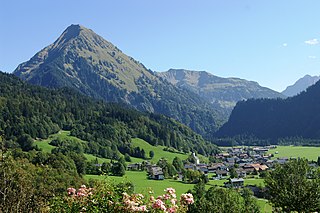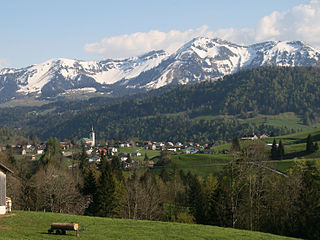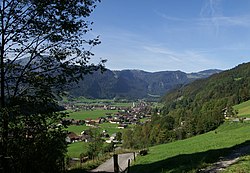
Vorarlberg is the westernmost state of Austria. It has the second-smallest geographical area after Vienna and, although it also has the second-smallest population, it is the state with the second-highest population density. It borders three countries: Germany, Switzerland, and Liechtenstein. The only Austrian state that shares a border with Vorarlberg is Tyrol, to the east.

The Bregenzerwald is one of the main regions in the state of Vorarlberg (Austria). It overlaps, but is not coterminous with, the Bregenz Forest Mountains, which belong to a range of the Northern Limestone Alps, specifically the northern flysch zone. It is the drainage basin of the Bregenzer Ach river.

Reuthe is a municipality of the Bregenzerwald, in the westernmost Austrian state of Vorarlberg. It is located in the district of Bregenz. Its main industry is tourism.

Au is a town in the Bregenz Forest in Vorarlberg (Austria).

Mellau is a town in the Bregenz Forest in the westernmost Austrian state of Vorarlberg, part of the district of Bregenz.

Bizau is a town in the Bregenz Forest in the Austrian state of Vorarlberg, part of the district Bregenz. The municipality has around 1080 inhabitants.

Egg is a market town in the Bregenz Forest, in the western Austrian state of Vorarlberg, part of the district of Bregenz. It is the has the highest population of any community in the Bregenzerwald.

Schwarzenberg is a municipality in the Bregenz Forest in the western Austrian state of Vorarlberg, part of the district of Bregenz. Schwarzenberg has an area of 25.76 km². It lies south of Lake Constance. The village center is heritage-protected for its traditional rustic wooden houses.

Krumbach is a village in the westernmost Austrian state of Vorarlberg, in the Bregenz district. The municipality has about 1,000 inhabitants.

Schoppernau is a town in the Bregenzerwald Region of the Austrian state of Vorarlberg. Schoppernau has an area of 47.64 km2.

Damüls is a village community and popular tourist resort in the district of Bregenz in the westernmost Austrian state of Vorarlberg.

Andelsbuch is a municipality in the district of Bregenz in the Austrian state of Vorarlberg.

Hittisau is a municipality in the district of Bregenz in the Austrian state of Vorarlberg. Hittisau has a surface area of 46.65 km2. It lies in the Bregenzerwald in the west of the country.

Langenegg is a municipality with approx. 1,200 inhabitants in the westernmost Austrian state, Vorarlberg.

Lingenau is a municipality in the district of Bregenz, in the westernmost Austrian state of Vorarlberg.

The Bregenz Forest Railway, is an Austrian narrow gauge railway with a track gauge of 760 mm, the so-called Bosnian gauge. It runs through the state of Vorarlberg and from 1902 to 1983 linked Bregenz on Lake Constance with Bezau in the Bregenz Forest on a 35.33 kilometre long railway line. Today only a 5.01 kilometre long section is still worked as a heritage railway. The remaining line has been closed and largely lifted.

Kaspar Albrecht was an Austrian architect and sculptor.

The KäseStrasse Bregenzerwald is a non-profit organisation and route which links cheese-producing businesses of the Bregenz Forest in Vorarlberg (Austria).

The Egg Museum is a local history museum located in Egg in the Austrian state of Vorarlberg. It is the oldest regional museum in Vorarlberg. The museum was founded in 1904 and reopened again in 1988.

Vorarlberger Bergkäse is a regional cheese specialty from the Austrian state of Vorarlberg. It is protected within the framework of the European designation of origin (PDO).



























